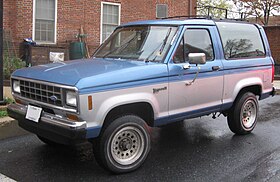Ford Bronco II
| Ford Bronco II | |
|---|---|

1983-1988 Ford Bronco II XLT
|
|
| Overview | |
| Manufacturer | Ford |
| Model years | 1983–1990 |
| Assembly | United States: Louisville, Kentucky (Louisville Assembly) |
| Body and chassis | |
| Class | Compact SUV |
| Layout | Front engine, rear-wheel drive / four-wheel drive |
| Related | Ford Ranger |
| Powertrain | |
| Engine | 2.8 L Cologne V6 2.9 L Cologne V6 2.3 L Mitsubishi 4D55T turbodiesel I4 |
| Transmission |
Manual 4-speed Mazda TK4 5-speed Mazda TK5 5-speed Mazda M5OD-R1 5-speed Mitsubishi FM145 5-speed Mitsubishi FM146 Automatic 3-speed C5 4-speed A4LD |
| Dimensions | |
| Wheelbase | 94.0 in (2,388 mm) |
| Length | 1983-1988: 158.3 in (4,021 mm) 1989-1990: 161.9 in (4,112 mm) |
| Width | 68.0 in (1,727 mm) |
| Height | 1983-1988: 68.2 in (1,732 mm) 1989-1990: 69.9 in (1,775 mm) |
| Chronology | |
| Successor | Ford Explorer |
The Ford Bronco II is a two-door compact-sized four-wheel-drive sport utility vehicle (SUV) that was manufactured by Ford from 1983 to 1990. Following the shift of the Bronco to the F-Series truck platform in 1978, the Bronco II was developed as an all-new compact SUV. Although the original Bronco used its own chassis, the Bronco II utilized a shortened Ford Ranger chassis, allowing for mechanical and structural commonality.
The Bronco II was assembled in the Louisville Assembly Plant in Louisville, Kentucky, alongside the Ford Ranger. In 1990, the Bronco II was replaced by the Ford Explorer; while still based on the Ranger, the Explorer was enlarged into the mid-size SUV segment. Following the discontinuation of the Bronco II, the next compact SUV produced by Ford in North America was the 2001 Ford Escape.
The first Bronco II was developed in parallel with the Ranger pickup truck that was introduced for the 1982 model year. Introduced in March 1983, Ford marketed the Bronco II as a "vehicle for men, single people, or young couples ... almost like John Wayne vehicles ... that gave people the sense that they could conquer anything ..." While the Bronco II was nearly a foot shorter than the competing Chevrolet S-10 Blazer (introduced for 1982), the use of the Ranger chassis allowed for lower production costs by using a common assembly line with many shared components.
For 1988, the Bronco II was restyled alongside the Ranger. The exterior featured new front bodywork with new a new hood, front fenders, and a closer-fitting front bumper. Inside, the dashboard was redesigned, featuring a new instrument panel. Alongside the overall change in appearance, the new bodywork marked improvements in structural support.
As a running change, four-wheel drive 1990 models produced after November 1989 were produced with Dana 35 front axles, replacing the previous Dana 28 front axle.
The 1984 and 1985 models were equipped with the German-built carbureted 2.8 L Cologne V-6 with 115 hp (86 kW) at 4600 rpm, which was also used in the 1984 and 1985 Ford Ranger. It was originally available exclusively with four-wheel drive. The 1986 model year introduced the 140 hp (104 kW) fuel injected 2.9 L Cologne V-6. Due to a design flaw, overheating the engine could lead to cracks in the cylinder head between the valve springs or at the base of the rocker shaft pedestals. This results in internal coolant leaks causing contamination of the oil, which if not caught in time causes severe internal engine damage. Although there were slight improvements to the head castings in late 1989, these heads were not installed on production engines before the production of the Bronco II ceased. Bronco IIs that were still under warranty, or at the owner's desire, were retrofitted with the improved heads.
...
Wikipedia
